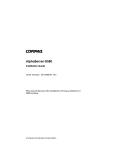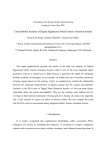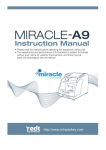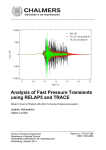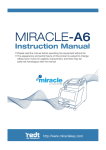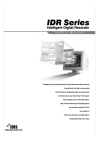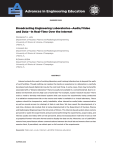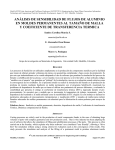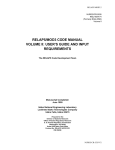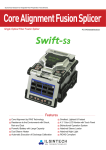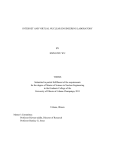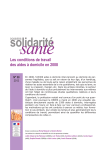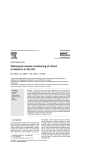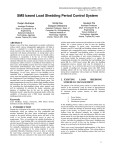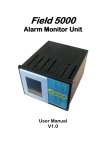Download A web-based nuclear simulator using RELAP5 and LabVIEW
Transcript
Nuclear Engineering and Design 237 (2007) 1185–1194 A web-based nuclear simulator using RELAP5 and LabVIEW K.D. Kim a,∗ , Rizwan-uddin b a b Korea Atomic Energy Research Institute (KAERI), Dukjin 150, Yusung, 305-353 Taejon, Republic of Korea University of Illinois at Urbana-Champaign (UIUC), Department of Nuclear, Plasma and Radiological Engineering, 103 S. Goodwin Ave., Urbana, IL 61801, USA Received 20 September 2006; received in revised form 7 January 2007; accepted 8 January 2007 Abstract A web-based nuclear reactor simulator has been developed using the best-estimate nuclear system analysis code RELAP5 as its engine, and LabVIEW for graphical user interface and web-casting. Simulator retains the accuracy of the best-estimate code. Results are displayed in user friendly graphical format. Color-coded nominal values are displayed along with the current status of different variables in tab activated windows. Some variables of interest are also shown as a function of time. All graphical outputs are displayed in web browsers making the simulator’s front end independent of the operating system. The interactive simulation feature allows the users to simulate specific reactor transients – such as LOCA, scram, etc. – using a single click. Simulator’s graphical output can be web-casted and is thus available to anybody with access to the web. Moreover, if permitted, the simulator can be operated remotely from another site connected to the server via the World Wide Web. © 2007 Elsevier B.V. All rights reserved. 1. Introduction Large system analysis computer codes such as RELAP5 (US NRC, December 2001), RETRAN (Computer Simulation & Analysis, 2001), TRAC-M (US NRC, April 2001), CATHARE (Farvaque, 1992), MARS (Jeong et al., 1999), etc. have played an important role in evaluating nuclear reactor systems for a wide range of planned and accidental conditions. Most of these codes required high performance computers to simulate complicated reactor phenomena. However, rapid advances in computer technology now enable these codes to run on personal computers or workstation in real or nearly real time. This has helped in more widespread use of these codes. One limitation that still restricts their use on an even wider scale is that these codes often have complicated I/O structure. User friendly graphical user interfaces (GUI) will not only help in their increased use, they are also likely to help in better and efficient interpretation of the results obtained using these codes. This has motivated the development of easy-to-use GUI tools for best-estimate codes, such as SNAP (Jones, 2000) and PEGASYS (Agee, 1996). Some ∗ Corresponding author. E-mail addresses: [email protected] (K.D. Kim), [email protected] ( Rizwan-uddin). 0029-5493/$ – see front matter © 2007 Elsevier B.V. All rights reserved. doi:10.1016/j.nucengdes.2007.01.004 GUIs have been developed so that the system codes can be used like a conventional nuclear plant analyzer (NPA) (Bartsoen et al., 1997; Maselj et al., 1997; Kim et al., 2001, 2003). In addition to the user friendly interfaces, real time webcasting of results obtained using these codes in GUIs is also desirable. With easy accessibility and fast Internet communication, a greater degree of freedom in simulation and/or analyses of nuclear transient conditions can be achieved if computer codes – and their output – are accessible from anywhere in the world through the web. Such a web-based interactive interface can also be very useful for team work when there is a need to share real time data. With increasing emphasis on team work, with teams often located in geographically distant locations, such a capability can act as the bridging interface allowing better collaboration and interactive exploration of real time data. Using mostly off-the-shelf technology, development of such a capability – a web-based nuclear reactor simulator based on a best-estimate code and with user friendly interface – is reported here. Specifically, a user friendly, graphical interface is developed to execute and to display the voluminous output of the widely used best-estimate code RELAP5. Moreover, a capability to web-cast that I/O interface in real time is also available. This has been achieved using the virtual instruments (VIs) feature available in LabVIEW (Laboratory Virtual Instrument Engineering Workbench); a commercially available package for data 1186 K.D. Kim, Rizwan-uddin / Nuclear Engineering and Design 237 (2007) 1185–1194 acquisition and visualization. In addition to the graphical display of the large quantity of data that is generated by such codes, interactive control functions have also been added that allow simulation of operator actions such as scram, etc. Operator actions can be initiated by the local user as well as, if permitted, by the distant user through the web. The key features of this web-based nuclear simulator are summarized below: • RELAP5 forms the engine of this simulator. Hence, all standard RELAP5 features are available in this simulator. Moreover, existing RELAP5 input data files can be used. • A LabVIEW based graphical user interface has been developed to display the large amount of output data “during” as well as “after” the transient simulations. • Simulator can be run on a server by users who are allowed to access the server through the web. Since all interactions take place via a web browser, it is machine independent. Remote users accessing/running the simulator see the results in windows that open in the web browser. • Interactive control functions are provided so that users (local as well as remote) can perform operator actions during the simulations. The simulator is developed using RELAP5 as its engine. However, the methodology used here for the web-based nuclear simulator is very general, and it can be easily extended to other system analysis codes. The tools and methodology used to develop the web-based nuclear simulator are presented in the next section. 2. Tools and methodology Development of a web-based simulator can be broken into two steps: identification of an “engine”; and development of a GUI. A personal computer with Windows OS was used as the developmental platform. This choice was primarily dictated by the fact that the dynamic link library (DLL) for RELAP5, which was chosen as the engine for the simulator, was generated in the Windows environment. [However, since the user interaction is via a web browser, the simulator can be used with other machines, and operating systems other than Windows.] RELAP5 is selected as the engine of this simulator because of its widespread use worldwide. RELAP5 input decks for most nuclear plants are already available, and can be directly or with very minor modifications used with the simulator developed here. [The choice was also, at least partly, dictated by the desire to develop a means to graphically display the voluminous text-based output generated by RELAP5.] LabVIEW 8.0 (National Instruments, 2003) was used to develop the graphical user interface (GUI) of the web-based nuclear simulator. LabVIEW has been used in the past in laboratories (Oliveira et al., 1998; MacLaren et al., 1999) and is routinely used to process experimental data. It has recently been used to develop web-based virtual laboratory (Jurcevic et al., 2006; White, 2006), but it has not been used as a front end of a large system analysis nuclear simulation software, as is done in the application reported here. The sub-programs added for the DLL programming are located in a separate directory and maintained as an independent static library. The RELAP5 files that have been modified to implement the interactive control feature are also saved in a directory different from the one where these sub-programs (or subroutines) are saved in a standard version of RELAP5. The number of variables for the interface between RELAP5 dynamic link library (DLL) and virtual instruments (VIs) in LabVIEW is minimized to simplify the interface. Standard input decks of RELAP5 are used as input for this simulator. Since interactive control feature has been added, control parameters for this new feature however must be provided along with the standard RELAP5 input. The interactive, web-based user interface is developed using the virtual instruments feature in LabVIEW. LabVIEW—virtual instrument (LabVIEW-VI) is a powerful and flexible graphic programming language. It provides a platform to efficiently develop user interfaces and to display data. Moreover, with the click of a mouse it provides a web-based running environment. For LabVIEW programming, a modular approach was adopted. Each module is encapsulated with well-defined interfaces. The modules, such as the core power, temperature, pressure, etc., are then simply assembled together to create the complete simulator. This modular approach reduces the programming effort and the complexity of the design. Because each component is independent and self-contained with well-defined interfaces, it can be repeatedly used, saving time and effort in future development work. The simulator developed here taps into the data directly from the RELAP5 arrays for the variables to be plotted. This allows the display of data while simulation is still continuing. LabVIEW-VIs are coupled with RELAP5 as dynamic link library (DLL). RELAP5 main program is changed into a subprogram, and is exported to LabVIEW. The changes made to accomplish this are shown in Appendix A. The same appendix also shows a new sub-program, set files, added to set up the I/O files. Also, as an example, the part of RELAP5 minor edit input and the related part of a new sub-program to graphically show the output of RELAP5 in the LabVIEW-VI are shown and described in Appendix A. Fig. 1 shows a schematic diagram of the web-based engineering simulator. The user provides the input and output file names for RELAP5 DLL via the main control module by either entering the path and name of the file, or by simply browsing through the storage media on the computer. These paths and file names are transferred to RELAP5 DLL when user clicks on the “run” button in the main control module. The simulator runs using these files as input decks. Local or remote master user, who has the control of the simulator, can simulate operator’s actions through the main control page, and this control action is also passed to RELAP5 DLL through LabVIEW-VIs. During the transient calculation, the RELAP5 DLL transfers the results to LabVIEW, and the LabVIEW-VIs show the data in graphical form. Through Internet, the users connected to the server running the simulator can access the graphical output of LabVIEW-VIs. LabVIEW-VIs, which are coupled with RELAP5 as DLLs, make it possible to run RELAP5 from a web-browser through the network without the code and/or input file being present in K.D. Kim, Rizwan-uddin / Nuclear Engineering and Design 237 (2007) 1185–1194 1187 Fig. 1. Schematic diagram of a web-based nuclear simulator. the end user’s computer. The simulator can reside on a server. Users who are permitted to be connected to the server through the Internet can interactively simulate the transient in interactive mode using control features through their web browser and examine the results on-line. Each user interface screen in the web-based simulator, which will be called a module, is a LabVIEW virtual instrument. Each module consists of elements such as a windows, meters, switches, etc. Since LabVIEW-VI is a graphical language, the graphic elements within each module can be replaced by other instruments or modified using such simple mouse operation as drag and drop. User interface screens in the web-based nuclear simulator developed here consist of six modularized LabVIEW-VIs: a main control module for problem set up and interactive control; and five RELAP5 output visualization modules. Local or remote master user can select the code I/O files, execute the code and simulate operator’s action through the main control page which appears in their web browser when they connect to the server. The main control window as well as other windows displaying the data can be web-casted over the Internet. However, only one master user or client can control the transient simulation. It should be noted that the RELAP5 input data can be used without any changes. However, to fully utilize the capabilities of this tool, additional input cards must be added into the existing RELAP5 input deck to specify the parameters for the interactive control features. 3. Main features Main features of this web-based nuclear simulator are explained using an example of a typical Westinghouse two-loop PWR (Pressurized Water Reactor), modeled as the target plant for this application. While results shown here are for one spe- cific nuclear power plant, the simulator can easily be adapted for other plants. Specific details for adapting this tool to other LWRs are given later in this section. 3.1. Control module Fig. 2 shows the main window (a LabVIEW virtual instrument) of the web-based nuclear simulator. It consists of a main tool bar and five tab sheets. The tab sheets include the “main control”, “nodalization”, “reactor power”, “pressure & level” and “temperature.” Each tab sheet is developed as a separate module or virtual instrument. Output data can be seen in graphical format by selecting appropriate tabs at the bottom of the simulator window. This leads to the display of the selected data in the currently open window. Option is also available to open new windows to display the selected data. Hence, a user can select to view the data in a separate window or web browser (open in new window) by clicking on the buttons on the left side of the main window (under, stand-alone pages). Contents of these tab sheets are discussed in more detail below. User can control the execution mode using the buttons for run, stop and pause on the main tool bar (see inset in Fig. 2). The main control module is designed to set up the I/O files, code execution, accident initiation, simulation of reactor control, and to open other output pages in separate browser windows. The main control module has three edit boxes and associated buttons to browse and select the input, output, and restart data files. User can execute (start) the RELAP5 code or pause/resume the execution by clicking a button in the main tool bar on top of the window shown Fig. 2. User can terminate the execution by clicking the stop button on the top-right corner of the window shown in Fig. 2. [Although there is an alternate method to terminate the execution by clicking the “stop” button in the main tool bar, it is not recommended because it forces the ter- 1188 K.D. Kim, Rizwan-uddin / Nuclear Engineering and Design 237 (2007) 1185–1194 Fig. 2. Main control page. mination by LabVIEW intrinsic function without following the proper termination procedure.] Few frequently used transient simulation scenarios, such as LOCA, steam generator tube rupture and built-in trip control functions such as reactor scram and reactor coolant pump ON/OFF, are made available as single click switches. Since current work is only to demonstrate the capabilities and feasibility of a web-based simulator using LabVIEW, the GUI currently does not provide interactive features to control all aspects of a reactor. However, additional interactive controls can be added without significant effort. The red button is used as a reactor scram switch as well as an indicator to show the reactor’s current status. Two toggle switches show the current status of the reactor coolant pumps and two push buttons above these switches are used to select the auto/manual mode. Access to reactor output data in graphical form is available by clicking on the tabs at the bottom left of the window shown in Fig. 2, which results in display of the clicked module in the same window (replacing the control window). User can also elect to view the data in newly opened windows by clicking on the desired module button on the left edge of the control module (buttons under the heading; Stand-alone Pages) shown in Fig. 2. transient simulation so that the users can easily follow plant dynamics. There are five data modules that can be accessed to display a wide range of data. These are described below. 3.2. Data visualization modules 3.2.1. Reactor power module A picture of the reactor power module is shown in Fig. 3. It shows major reactor power related parameters through indicators and trend graphs. Specifically, this module shows: total reactor power; fission power; major contributions to the reactivity worth; fuel centerline temperatures along five different axial positions; and reactor core collapsed water level. This module is designed to display important reactor power related variables as well as parameters that lead to change in power. For example, user can easily analyze the contributions to a change in reactor power by examining the reactivity effects and fuel temperatures which affect Doppler feedback. Operating range for reactor power is indicated with green color in the reactor power indicators, and the power levels above the high reactor power set point are marked in red. RELAP5 input model was prepared to automatically scram the reactor if reactor power is above the high power set point. Core water level is included to show the increase in fuel temperature due to uncovered core during loss of coolant or steam line break accidents. Trend graph shows the change of reactor power with time. RELAP5 produces a large amount of text-based output in a transient simulation. Web-based nuclear simulator is designed to provide graphical displays of the results during or after a 3.2.2. Pressure and level window Pressure and water levels on the primary and secondary sides are very important parameters for reactor operation and reactor K.D. Kim, Rizwan-uddin / Nuclear Engineering and Design 237 (2007) 1185–1194 1189 Fig. 3. Reactor power module. safety evaluation. This window shows pressures and collapsed water levels for the pressurizer and two steam generators using meters for pressure, level indicators for water level, and trend graphs. See Fig. 4. The state of the primary side pressure and water inventory is shown using the pressurizer pressure and pressurizer water level. Steam dome pressure and narrow range water levels show the state of the pressure and water inventory of the secondary side of the two steam generators. These instruments also show reactor’s normal operating range in green color, above high-high set point in red color and below low-low set point in yellow color, thus making it very easy to assess reactor’s current operating status. This window also includes the trend graphs for pressures and water levels for pressurizer and secondary side of steam generators. 3.2.3. Temperature window This window, shown in Fig. 5, shows hot leg, cold leg and average temperatures for each loop. These temperatures indicate Fig. 4. Pressures and water levels. 1190 K.D. Kim, Rizwan-uddin / Nuclear Engineering and Design 237 (2007) 1185–1194 Fig. 5. Temperature window. such reactor operating conditions as thermal power generated on the primary side, reactor over cooling and under cooling, etc. This window also shows, for each leg, the saturation temperatures with red bars on the upper part of the thermometers. This information is crucial in determining the level of sub-cooling margin that must be maintained to protect the reactor coolant pump. These temperatures are also shown in trend graphs as a function of time. Fig. 6. Flow rates window. K.D. Kim, Rizwan-uddin / Nuclear Engineering and Design 237 (2007) 1185–1194 1191 Fig. 7. Nodalization window. 3.2.4. Flow rate window Flow rates for the primary loop and charging/letdown flows and various secondary flows are included in this window shown in Fig. 6. Primary loop flows are essential for reactor cooling, and charging/letdown is used to maintain water inventory on the primary side. On the secondary side, main and auxiliary feedwater flow, steam flow for each steam generator and turbine isolation flow and steam depressurizing valve flow are shown in the window. These flows are also shown in trend graphs as a function of time. 3.2.5. Nodalization window Conventional simulators are often based on simplified models and coarse computational cells. This does not permit evaluation and display of spatial distributions of quantities of interest. Since RELAP5, a code that calculates fairly detailed spatial distributions, is the engine behind the simulator developed here, it is possible to display the evolution of spatial distribution of quantities of interest such as temperature or void fraction, etc. The nodalization window is designed to show void distribution in nuclear steam supply system. Color is used to show the level of void fraction in each cell. Dark blue represents 100% water, and decreasing intensity of blue shows an increasing amount of void. Fig. 7 shows the change in void fraction distribution during a large loss of coolant accident. The figure on the left shows the void distribution during normal operating conditions, and the one on the right shows void distribution about 100 s after the accident. Windows and variables shown in the figures above are for a specific two-loop PWR. However, the target plant can be easily replaced by another plant by simply changing the RELAP5 input file. Data windows showing scalars for a different plant design, for example for a four loop plant, will however require some minor modifications to display the additional variables for the different plant design. In the current version of the simulator, nodalization window is the only window that displays spatial distribution of a variable (void fraction). Since, geometry and number of cells may vary from plant to plant and from one simulation to another, the nodalization window must be tailored for each plant geometry and the number of cells. This may require a moderate amount of effort to tailor the simulator’s nodalization window for the geometry and the number of cells used in any plant simulation. 4. Summary and conclusions A web-based nuclear reactor simulator based on RELAP5 has been developed using LabVIEW-VIs. RELAP5 was selected as the engine for this simulator since it is a very widely used bestestimate code that has been well-verified over several years. Moreover, RELAP5 input decks for most nuclear power plants are already available which makes it relatively easy to tailor the simulator for these power plants. Although the web-based simulator was developed for a particular PWR plant, it can be developed for other nuclear plants and experimental facilities by changing the input deck of the RELAP5 code, and making minor modifications in the data display windows. The simulator engine (RELAP5) can also be switched with any other system analysis code since the interface between the simulator engine and graphical user interface program is well-defined and the two are coupled by dynamic link libraries. LabVIEW has been used as a development environment and as generic graphical user interface because LabVIEW is based on a graphical language which is easy to use, provides excellent graphics capabilities, and moreover, it has the ability to make all results available, in real time, on the World Wide Web. Such web-based simulation capabilities can also be very useful for team work such as international and/or distance collaborations. Future work will focus on adding additional interactive features for operator actions as well as extending the development to GEN-IV reactor designs. Acknowledgements This work was supported in part by the US DOE INIE grant. K.D. Kim acknowledges the support from Korea Science and Engineering Foundation (KOSEF) for partially supporting the visit to UIUC. Work was performed while K.D. Kim was a visiting scientist at UIUC. 1192 K.D. Kim, Rizwan-uddin / Nuclear Engineering and Design 237 (2007) 1185–1194 Appendix A Slight changes are made in seven RELAP5 subroutines and six new subroutines are added to generate the dynamic link library to couple RELAP5 with LabVIEW-VI. Two examples of the changes made to RELAP5 code are shown and described below. RELAP5 main program was changed to a sub-program for LabVIEW. Sub-program set files, shown below, is added to set up the I/O files. K.D. Kim, Rizwan-uddin / Nuclear Engineering and Design 237 (2007) 1185–1194 1193 To minimize the changes in RELAP5 input, the values of parameters graphically shown in the LabVIEW-VI are obtained from the RELAP5 minor edit variables. A sub-program named r5m33 data is added to get the values of the minor edit variables, and to pass the information for the control parameters including interactive control function, program control between RELAP5 DLL and LabVIEW-VI. Following part of sub-program, r5m33 data, is to export the values of minor edit variables to LabVIEW for graphical representation and web-casting. Following is the part of RELAP5 input to define minor edits: 1194 K.D. Kim, Rizwan-uddin / Nuclear Engineering and Design 237 (2007) 1185–1194 References Agee, L.J., 1996. Status of EPRI software. In: Presented at Korea Electric Power Corp., Electric Power Research Institute. Bartsoen, L., Mandy, Cs., Stubbe, E., 1997. Nuclear plant analyzer: an efficient tool for training and operational analyses. In: Proceedings of the Second CSNI Specialist Meeting on Simulators and Plant Analyzers, Finland. Computer Simulation & Analysis, Inc., 2001. RETRAN-3D: A Program for Transient Thermal–Hydraulic Analysis of Complex Fluid Flow Systems, vol. 1: Theory and Numerics. Electric Power Research Institute, EPRI NP-7450. Farvaque, M. 1992. User’s manual of CATHARE 2 V1.3E, CEA, STR/LML/EM/91-61. Jeong, J.J., Ha, K.S., Chung, B.D., Lee, W.J., 1999. A multi-dimensional thermal–hydraulic system analysis code, MARS 1.3.1. J. Korean Nucl. Soc. 31 (3), 344–363. Jones, K.R., 2000. Symbolic nuclear analysis package. In: Proceedings of the 2000 ANS/ENS International Mtg, Embedded Topical Mtg. #2, “Best Estimate” Methods in Nuclear Installation Safety Analysis, Washington, DC, November 12–16. Jurcevic, M., Malaric, R., Sala, A., 2006. Web based platform, for distance training on Electrical Measurements Course, Measurement Science Review, vol. 6, Sec. 1, No. 4, 2006. Available via Web at http://www. measurement.sk/2006/S1/Jurcevic.pdf. Kim, K.D., Lee, S.W., Jeong, J.J., 2001. A visual environment for system analysis codes. Prog. Nucl. Energy 39 (3–4), 335–344. Kim, K.D., Lee, S.W., Jeong, Lee, Y.J., Chung, B.D., Hwang, M.G., 2003. Development of a nuclear reactor transient analyzer based on the best-estimate codes, RETRAN and MARS. Trans. ANS 89. MacLaren, S., Faltens, A., Ritchie, G., Seidl, P., 1999. Preliminary Results from a Scaled Final Focus Experiment for Heavy Ion Inertial Fusion. In: Proceedings of the 1999 Particle Accelerator Conference, New York. Maselj, A., Vonjovic, D., Gregoric, M., 1997. NPA applications: development in the nuclear safety authority framework. In: Proceedings of the Second CSNI Specialist Meeting on Simulators and Plant Analyzers, Finland. National Instruments, 2003. LabVIEW: Getting Started with LabVIEW. Oliveira, V.A., Aguiar, M.L., Silva Jr., W., 1998. User-friendly computer software in control and instrumentation teaching and learning. In: Proceedings of the International Conference on Engineering Education (ICEE98), Rio Othon Palace, August 17–20, p. 1998. US Nuclear Regulatory Commission, Office of Nuclear Regulatory Research, April 2001. TRAC-M/FORTRAN 90 (version 3.0) Theory Manual, US Nuclear Regulatory Commission Report NUREG/CR-6724, Washington, USA. US Nuclear Regulatory Commission, Office of Nuclear Regulatory Research, December 2001. RELAP5/MOD3.3 Code Manual Volume 1: Code Structure, System Models and Solution Methods, US Nuclear Regulatory Commission Report NUREG/CR-5535, Washington, USA. White, J.R., 2006. Available via web at http://nuclear101.com/.











